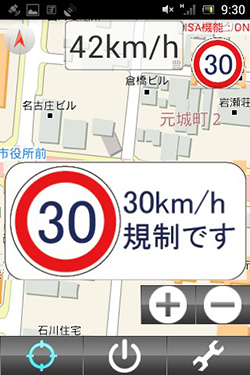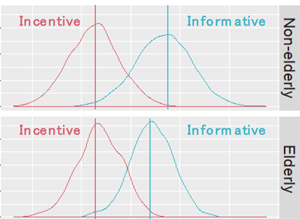
ここからコンテンツです。

Representation of driving behavior as a statistical model
To accurately measure the effectiveness of traffic safety management technology By Kojiro Matsuo
A joint research team led by Associate Professor Kojiro Matsuo at the Department of Architecture and Civil Engineering of Toyohashi University of Technology, in collaboration with Toyota Transportation Research Institute, and Daido University, has established a method to represent the variation in individual driving behaviors in a single statistical model, taking into account the effect of various external factors such as road structure. This method was applied to measure the effectiveness of Intelligent Speed Adaptation (ISA), which controls excessive speed violations. As a result, the research team found that in some cases, it is effective for drivers with a high tendency of frequent excessive speeding, and in other cases, effective only for elderly drivers depending on the style of the ISA. This method can be applied not only to ISA but also to measure the effectiveness of traffic safety management technologies that discourage drivers from using problematic driving behaviors.
Traffic safety has been recognized as a key global issue, as reflected in Target 3.6 of the 3rd Goal of SDGs, which is to reduce the number of traffic accidents by half. ISA is a traffic safety management technology that recognizes the speed limit of the road section based on the current position of the vehicle and provides speed information, over-speed warnings, mandatory speed control, and speed compliance incentives to prevent drivers from over-speeding. There has been active research on ISA since the 2000s, mainly in Europe. Most of the previous studies have measured the restrictive effects of excessive speeding by comparing the driving behavior of subjects before and after the introduction of an ISA with driving simulator experiments and field studies for various types of ISAs.
However, driving behavior varies greatly from driver to driver. In addition, the structural environment of the road is different in the field experiment for each driver. Therefore, it is important to measure the effects of various factors, such as the individual and driving environment, in order to spread the technology appropriately.

To resolve this issue, the research team has developed a method to accurately measure the effect of ISA by using a single statistical model to simultaneously estimate each driver's unique driving behavior, the effect of various external factors such as road structure, and the effect of ISA on excessive speeding.
"The foremost challenge to be solved was how to represent and demonstrate the hypothesis that ‘the difference in the driver's tendency to exceed the speed limit also affects the impact of ISA in the model. This method solves the problem by estimating a model that takes into account the correlation between the parameters that define the driver's tendency to exceed speed and those that define the effect of the ISA. Recent developments in the field of data science, such as Bayesian statistics and improvements in computer performance, have made it possible to apply this method with slightly more complex models to real-world problems." explains Associate Professor Kojiro Matsuo, leader of the research team.
Associate Professor Matsuo also says, "ISA research began as a graduation research topic by a student under my guidance. The student performed an in-depth analysis of the data obtained from an ISA field experiment conducted with our collaborator, Toyota Transportation Research Institute. As a result, it was found that in some cases, there is an association between the subjects' regular speeding tendency and the effectiveness of ISA, but in other cases, there is no association between the two. Therefore, we started to consider measuring the effect of using a statistical model instead of a simple comparative analysis before and after the introduction of ISA. As a result, we were able to represent the seemingly disparate driving behavior of different drivers in a single model and to find a law in it. It was extremely interesting work."

The research team believes that this method can be applied not only to measure the impact of ISA in reducing speeding, but also to assess the effectiveness of traffic safety management technologies in reducing the rate of dangerous driving, such as running a red light, not stopping at an intersection without traffic lights, and obstructing pedestrians from crossing at a crosswalk. We are hoping to contribute to the reduction of traffic accidents worldwide by further developing traffic safety management technologies and measuring their effectiveness.
Reference
Kojiro Matsuo, Mitsuru Sugihara, Motohiro Yamazaki, Yasuhiro Mimura, Jia Yang, Komei Kanno, Nao Sugiki (2020). Hierarchical Bayesian modeling to evaluate the impacts of intelligent speed adaptation considering individuals’ usual speeding tendencies: a correlated random parameters approach. Analytic Methods in Accident Research.
https://doi.org/10.1016/j.amar.2020.100125
ドライバーの運転挙動を1つの統計モデルとして表現
交通安全マネジメント技術の的確な効果計測にBy 松尾 幸二郎
豊橋技術科学大学建築・都市システム学系、(公財)豊田都市交通研究所、大同大学の共同研究チームは、道路構造など様々な外的要因による影響を考慮しつつ、ドライバーによって異なる運転挙動やその変化を1つの統計モデルで表現する手法を開発しました。本手法を、過度な速度超過を抑制するためのIntelligent Speed Adaptation (ISA) の効果計測に適用したところ、ISAの様式によっては、普段の速度超過傾向が高い人に効果的な場合や、高齢者のみに効果的な場合があることを見出すことができました。本手法はISAのみならず、ドライバーの様々な運転挙動の変容を促す交通安全マネジメント技術の効果計測に適用が可能です。
SDGsの目標3・ターゲット3.6に交通事故半減が掲げられるなど、交通安全は改善するべき世界的な課題として認識されています。ISAとは、車両が現在走行している道路区間の速度規制情報を認識し、速度情報提供、速度超過警告、強制速度制御、速度遵守インセンティブなどにより、ドライバーの過度な速度超過を抑制する交通安全マネジメント技術です。欧州を中心に2000年代以降ISAの研究が盛んになっています。それら既往研究の多くは、様々な様式のISAについて、ドライビングシミュレータ実験やフィールド実験により、当該ISA導入前後の被験者の運転挙動を比較することにより、その速度超過抑制効果を計測するものでした。しかしながら、運転挙動はドライバーにより大きく異なります。またフィールド実験ではドライバーによって走行する道路構造環境も異なります。従って、個人や走行環境といった多様な要因の影響を適切に捉えた効果計測を行うことが当該技術を適切に普及させる上において重要です。
そこで本研究チームでは、各ドライバー固有の運転挙動特性、道路構造など様々な外的要因による影響、ISAによる速度超過抑制効果を1つの統計モデルで同時に推定することで、的確な効果計測を行える手法を開発しました。
「特に解決するべき課題であったのが、『ドライバーの普段の速度超過傾向の違いがISAの速度抑制効果にも影響を与える』という仮説をいかにモデルで表現して実証するかでした。本手法では、ドライバーの速度超過傾向を規定するパラメータとISAの効果を規定するパラメータとの間に相関を考慮したモデルを推定するという方法により、その課題を解決しています。近年のベイズ統計学といったデータサイエンス分野の発展やコンピュータ性能の向上により、本手法のようなやや複雑なモデルの実際問題への適用が可能となりました。」 と、研究代表者の松尾准教授は説明します。
また松尾准教授は、「ISAの研究を始めたのは、指導学生の卒業研究テーマとしてでした。共同研究者である(公財)豊田都市交通研究所とともにISAのフィールド実験を行い、当該学生がデータを詳細に分析していたところ、被験者の普段の速度超過傾向とISAの効果の大きさに関連がある場合とない場合がある可能性に気づきました。そこで、単純なISA導入前後の比較基礎分析にとどまらず、統計モデルを用いた効果計測を考え始めました。その結果として、1つのモデルでドライバーによって一見ばらばらに見える運転挙動を表現し、そこに法則性を見つけることができたことは大変興味深い仕事でした。」 と話します。
研究チームは、本手法がISAによる速度超過挙動抑制のみならず、信号無視、信号の無い交差点での一時不停止、横断歩道での歩行者横断妨害といった様々な危険運転挙動の改善を促す交通安全マネジメント技術の効果計測に適用が可能だと考えています。今後、さらに交通安全マネジメント技術の開発とその効果計測を進め、世界の交通事故問題の改善に貢献していきたいと考えています。
Researcher Profile

| Name | Kojiro Matsuo |
|---|---|
| Affiliation | Department of Architecture and Civil Engineering |
| Title | Associate Professor |
| Fields of Research | Traffic Engineering / Infrastructure Planning |
ここでコンテンツ終わりです。
